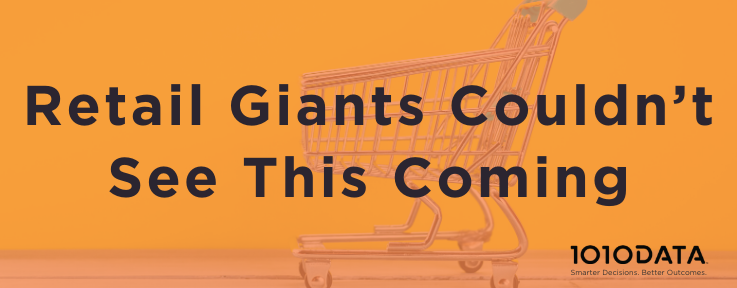
In April alone, 24% of new online customers were World’s Largest Retailer shoppers for the first time. Without the appropriate tools, you may have missed this too.
In just a few months the onset of COVID-19 has created previously unimaginable changes to our personal lives and to the business landscape. While some of these changes will become part of a new normal, other behaviors may revert back to the way they were pre-COVID, creating both challenges and opportunities for brands and retailers.
The suddenness of change, beginning on March 13th when the country started going into lockdown, was staggering. In February, unemployment was at a 50 year low and just two months later the country faced an unemployment rate worse than in the financial crisis. Along with the drop in unemployment came a drop in consumer spend of close to 40% compared to the prior year.
A change in buying behavior
The combination of mandated changes, like stay at home orders, combined with the uncertainty of the situation drove changes in consumer behavior starting with a stock-up phase for “essentials,” with categories like grocery growing 77% YOY and sales of pet supplies growing over 40% YOY. This was accompanied a by a mandated shift to staying and working at home, which increased sales of office supplies over 70% YOY and accelerated the adoption of delivery services.
Faced with a situation that most had never seen before, the urgency to stock up on essential items created what amounted to a consumer treasure hunt as people tried different retailers and brands to find in stock items to buy. For example, we saw online sales of toilet paper initially spike at warehouse clubs where people were buying in bulk. When they ran out, consumers moved to retailers like Walmart Grocery and ultimately at less traditional retailers for the category, like office stores and then Instacart.
Customers hunting in new online platforms means new customers. While it may be hard to get someone into a different supermarket than they normally shop at, eCommerce makes switching across channels easier.
With crisis comes opportunity
As customers adopted new services and tried new retailers for their shopping needs, clear opportunities for retailers and brands to drive new business and create loyalty were created.
The adoption of grocery delivery has been a big winner. While the category was already growing, COVID-19 has been an accelerator. For example, Instacart went from an average of 18.5% new customers per month to over 46% in March and April. Beyond just the scale of customer acquisition, the value of each customer is large, with the average Instacart customer spending $767 on the platform in their first year.
With a limited group of physical retailers open, online buying accelerated with an influx of new buyers, as well as customers, trying new sites as they hunted for in-stock items. These changes have created opportunities to engage new customers for retailers ranging from big box players, like Walmart, to direct to consumer sites, like Kiehl’s, who have been nimble enough to adjust.
Walmart: Walmart.com has seen a large influx of new customers, which has created new relationships for the brand but also created opportunities to take share from an arch competitor, Amazon. Although considered an essential retailer, Walmart put in place investments in eCommerce and customer experience like order online and pick up in store that have paid off during COVID-19. Taking a look at their new buyer profile from April creates an understanding of their opportunity:
Kiehl’s: Their DTC site has greatly outperformed during COVID-19 by effectively executing against their social strategy and adding virtual product events to increase customer engagement. This paid off in a big way:
Moving forward
The pandemic has resulted in a cycle of extreme evolution that continues as states begin to reopen and stores regain stock. Will retailers and brands be able to retain new customers or win back those they lost? Will they be able to evolve with customer needs? Armed with the type of data referenced here, brands and retailers can have the information required to understand customer behaviors informing strategies to drive acquisition and loyalty.
Revisiting our example of the treasure hunt to find toilet paper, consumer data can enable an understanding of what else customers were buying when they jumped to new stores to find toilet paper and if they became repeat customers. Without the appropriate tools, all you would see was the headline “toilet paper hard to find.”
To learn more about the data behind this article and what 1010 data has to offer, please reach out to Andy Burrow at andy.burrow@1010data.com.







Sign up to receive our stories in your inbox.
Data is changing the speed of business. Investors, Corporations, and Governments are buying new, differentiated data to gain visibility make better decisions. Don't fall behind. Let us help.







Sign up to receive our stories in your inbox.
Data is changing the speed of business. Investors, Corporations, and Governments are buying new, differentiated data to gain visibility make better decisions. Don't fall behind. Let us help.